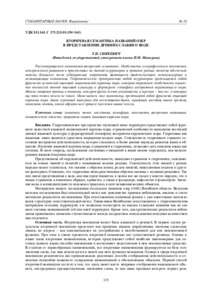Please use this identifier to cite or link to this item:
https://elib.psu.by/handle/123456789/20829Full metadata record
| DC Field | Value | Language |
|---|---|---|
| dc.contributor.author | Синкевич, Т. И. | - |
| dc.date.accessioned | 2017-12-06T08:51:46Z | - |
| dc.date.available | 2017-12-06T08:51:46Z | - |
| dc.date.issued | 2017 | - |
| dc.identifier.citation | Вестник Полоцкого государственного университета. Серия A, Гуманитарные науки. - 2017. - № 10. – C. 125-131. | ru_RU |
| dc.identifier.issn | 2070-1608 | - |
| dc.identifier.uri | https://elib.psu.by/handle/123456789/20829 | - |
| dc.description | Secondary Semantics Name of the Lake in the Representation of the Ancient Slavs About Water T. Sinkevich | ru_RU |
| dc.description.abstract | Рассматривается лимнонимия вторичной семантики. Особенности географического положения, исторического развития и присутствие на данной территории в прошлом разных этносов обеспечили наличие большого числа субстратных гидронимов, являющихся свидетельством межкультурных и межъязыковых контактов. Гидронимическое пространство любой территории представляет собой фрагмент целостной языковой национальной картины мира, которая отражает особенности мышления носителей данной языковой культуры и формирует специфику восприятия окружающего мира. Многие названия просты и понятны, история других точно установлена, а третьи – это те, о которых мы пока почти ничего не знаем. Отмечается, что лимнонимы, представляя собой фрагмент языковой картины мира, дают огромный материал для исследования быта, традиций, взглядов наших предков, помогают понять, каким образом шел процесс заселения наших земель.= the limnonymy of secondary semantics is considered. the peculiarities of geographical location, historical development and the presence of different ethnic groups in the past provided the availability of a large number of substrate hydronyms, which are evidence of intercultural and interlingual contacts. the hydromic space of any territory is a fragment of the integral linguistic national picture of the world, which reflects the features of the thinking of the bearers of a given language culture and shapes the specific perception of the surrounding world. Many of the names are simple and understandable, the history of others is precisely established, and still are those about which we do not know much yet. It is noted that the limnonyms, representing a fragment of the language picture of the world, give a huge material for the study of life, traditions, views of our ancestors, help to understand how the process of settling our lands was going. | ru_RU |
| dc.language.iso | ru | ru_RU |
| dc.publisher | Полоцкий государственный университет | ru_RU |
| dc.relation.ispartof | Веснік Полацкага дзяржаўнага ўніверсітэта. Серыя А, Гуманітарныя навук | be_BE |
| dc.relation.ispartof | Herald of Polotsk State University Series A, Humanity sciences | en_EN |
| dc.relation.ispartof | Вестник Полоцкого государственного университета. Серия A, Гуманитарные науки | ru_RU |
| dc.relation.ispartofseries | Серия A, Гуманитарные науки;2017. - № 10 | - |
| dc.rights | open access | ru_RU |
| dc.subject | Государственный рубрикатор НТИ - ВИНИТИ::ОБЩЕСТВЕННЫЕ НАУКИ::Языкознание | ru_RU |
| dc.subject | Лимноним | ru_RU |
| dc.subject | Этнос | ru_RU |
| dc.subject | Апеллятив | ru_RU |
| dc.subject | Метафора | ru_RU |
| dc.subject | Метонимия | ru_RU |
| dc.subject | Limnonym | ru_RU |
| dc.subject | Ethnicity | ru_RU |
| dc.subject | Appellative | ru_RU |
| dc.subject | Metaphor | ru_RU |
| dc.subject | Metonymy | ru_RU |
| dc.title | Вторичная семантика названий озер в представлении древних славян о воде | ru_RU |
| dc.type | Article | ru_RU |
| dc.identifier.udc | 811.161.1` 373.215:81:39(=161) | - |
| Appears in Collections: | 2017, № 10 | |
Files in This Item:
| File | Description | Size | Format | |
|---|---|---|---|---|
| 125-131.pdf | 311.85 kB | Adobe PDF |  View/Open |
Items in DSpace are protected by copyright, with all rights reserved, unless otherwise indicated.